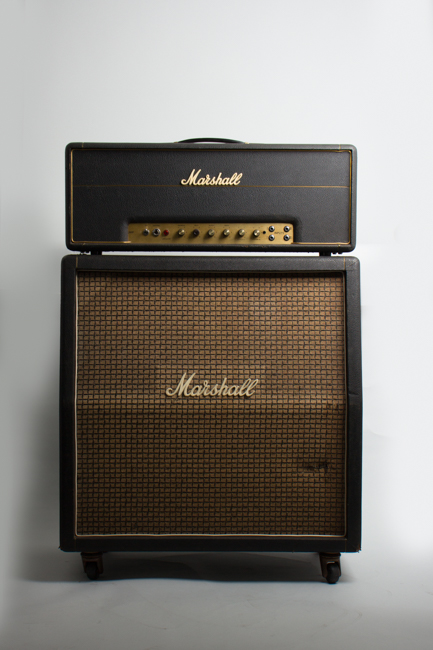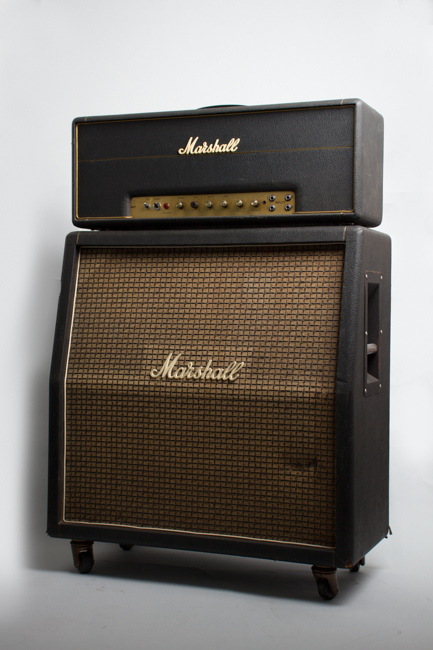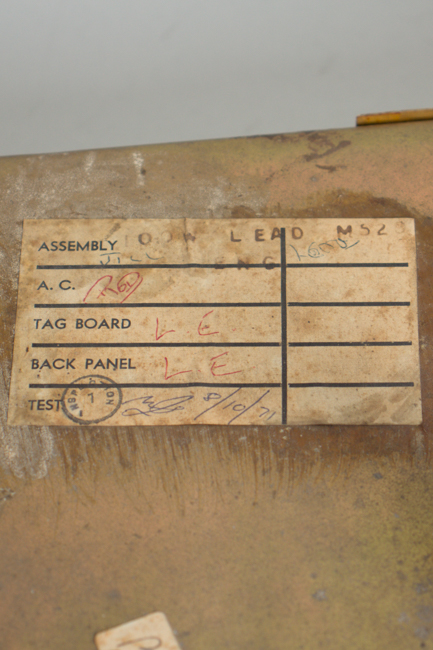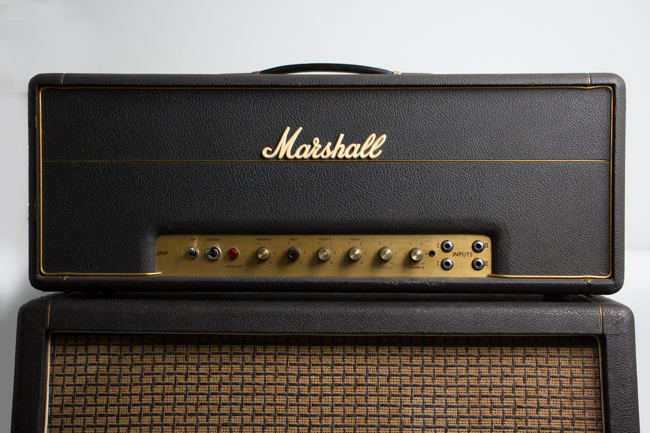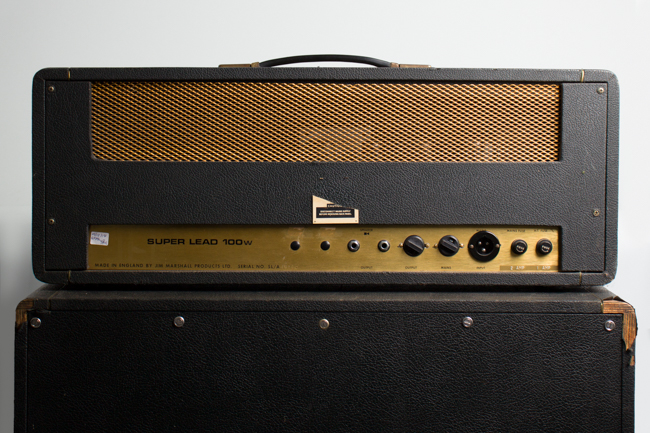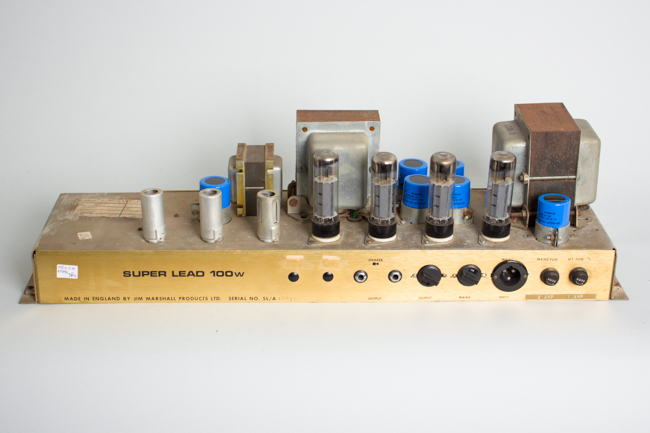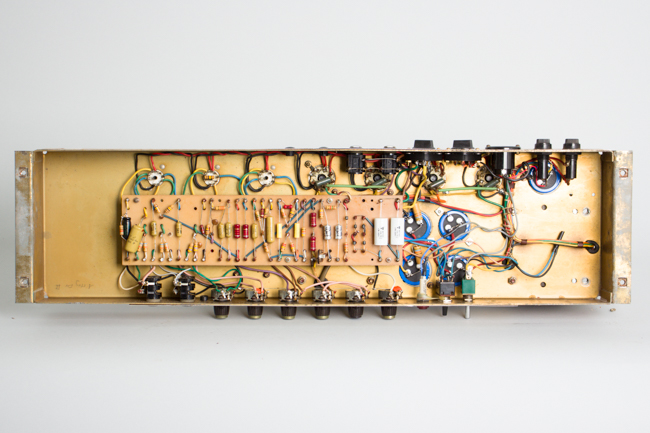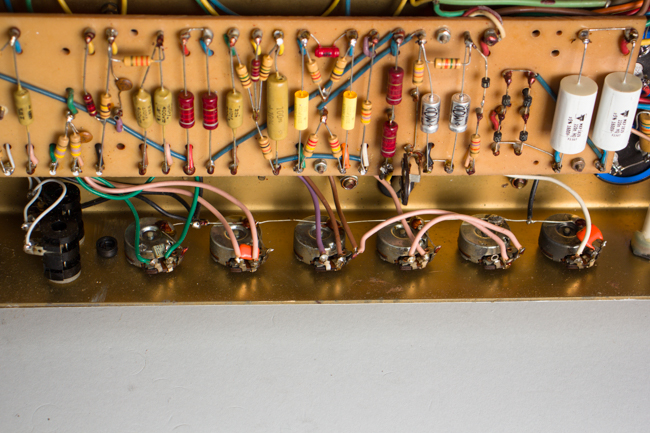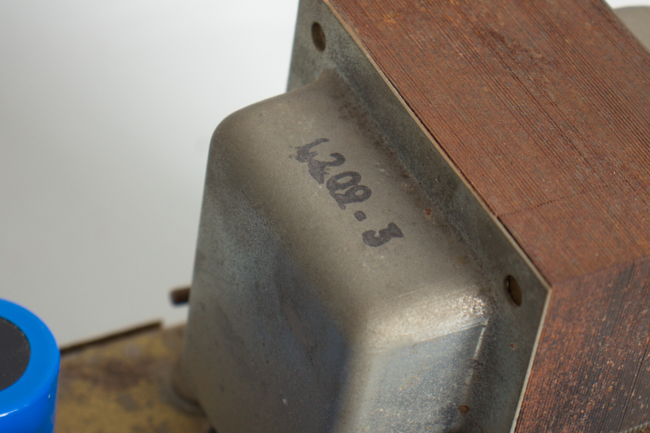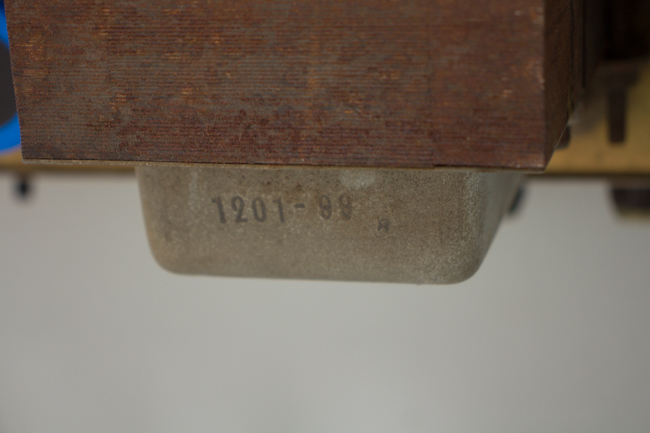Marshall JMP Model 1959 Super Lead 100 w/Model 1960 4x12" Extension Cabinet *LOCAL PICKUP ONLY* Tube Amplifier (1971)
Marshall JMP Model 1959 Super Lead 100 w/Model 1960 4x12" Extension Cabinet *LOCAL PICKUP ONLY* Model Tube Amplifier (1971), made in London, England, serial # SL-A 4659C, black tolex covering finish.
Marshall amps are certainly a rock legend, with a sound that has defined entire styles and eras of music. This 1971 Super Lead half-stack with its matching model 1960 4x12" cab is a fabulous example, both in volume and tone. Marshall amps owe their humble beginnings to the Fender Bassman 5F6-A, the original subject re-interpreted using English components and originally sold exclusively through Jim Marshall's London shop. Both the circuit design and sound soon evolved from the Fender paradigm into something entirely their own.
Early Marshalls powered the sound of the Who, Cream, Hendrix and beyond, becoming de rigeur among top UK groups by 1968. Similar to the Bassman, Marshall's Super Leads feature four inputs and two channels, often jumpered with a short lead for more preamp gain. Electronically, the three 100 watt Super Lead, Super Bass and Super PA models were nearly identical, save for a few minor preamp voicing components, making it easy to modify one circuit into the other. All three share the same treble, middle, bass and presence controls and a separate volume control for each of the four channels.
Like the other "Super" models, the head sports a quad of EL34 power tubes, putting out a whopping 100-watts, typically into a "full stack" of two of Marshall's iconic 4x12" closed-back Celestion G-12-laden cabinets. This was another Marshall innovation that owed much to The Who's Pete Townshend and John Entwistle, ever on the lookout for ways to make the band louder and early and eager advocates of this full-stack design.
This classically-styled JMP Super Lead is an relatively early example, just after the switch from the plexiglass panels. The serial number ends with the date code "C", indicating assembly in 1971. The cabinet serial number (41573) and visible speaker codes also date the cabinet to 1971.
These amps came of age in the late 1960s, an era when bands routinely played large stadiums and festivals, often without PA sound reinforcement for the guitars. In 1969 amplifiers with this sort of power were a necessity rather than a luxury, and the tone became the new rock standard. These days, we also have the luxury of attenuators to tame these beasts somewhat and protect our ears!
Height is 11 in. (27.9 cm.), 29 in. (73.7 cm.) width, and 9 in. (22.9 cm.) deep.
Cosmetically, this half-stack has clearly seen some use but remains in nicely preserved condition for its age. The classic black Tolex covering shows moderate amounts of scuffing and overall wear, mostly around corners and edges. Both the original handle and the gold piping are present, with the hardware and vent mesh showing moderate amounts of corrosion.
The aluminum front panel is in great condition showing very little wear overall, though some of the stenciled lettering has worn off. There's a inexplicable extra small hole near the input jacks plugged with a plastic grommet. The original knobs show some corrosive staining, but are all intact, free of cracking and are all present, though the bass control is missing its top. The grille cloth on the cabinet is original and shows one tear towards the lower right corner. The handles do show come corrosion and the left was at some point curiously outfitted with a switch that has since been disconnected. The original casters are present and still have plenty of life left in them.
Electrically, this amp is mostly original. All four 12" Celestion G12M speakers remain original with visible matching codes dating to April of 1971. They have all been professionally reconed and sound fabulous. The power and output transformers bear the codes 1201-99 and 1209-3, respectively and both appear original. All pots and choke appear original as well. The power switch has been replaced. The amp has otherwise seen our typical maintenance and servicing, including replacement of all electrolytic capacitors, install of a new grounded 3-prong power cord, all sockets, pots and jacks cleaned and power section biased to spec with a new matched quad of the robust and ever-reliable JJ EL34 power tube as this beast is, as they used to say, "Ready To Rock"! Very Good + Condition.
Marshall amps are certainly a rock legend, with a sound that has defined entire styles and eras of music. This 1971 Super Lead half-stack with its matching model 1960 4x12" cab is a fabulous example, both in volume and tone. Marshall amps owe their humble beginnings to the Fender Bassman 5F6-A, the original subject re-interpreted using English components and originally sold exclusively through Jim Marshall's London shop. Both the circuit design and sound soon evolved from the Fender paradigm into something entirely their own.
Early Marshalls powered the sound of the Who, Cream, Hendrix and beyond, becoming de rigeur among top UK groups by 1968. Similar to the Bassman, Marshall's Super Leads feature four inputs and two channels, often jumpered with a short lead for more preamp gain. Electronically, the three 100 watt Super Lead, Super Bass and Super PA models were nearly identical, save for a few minor preamp voicing components, making it easy to modify one circuit into the other. All three share the same treble, middle, bass and presence controls and a separate volume control for each of the four channels.
Like the other "Super" models, the head sports a quad of EL34 power tubes, putting out a whopping 100-watts, typically into a "full stack" of two of Marshall's iconic 4x12" closed-back Celestion G-12-laden cabinets. This was another Marshall innovation that owed much to The Who's Pete Townshend and John Entwistle, ever on the lookout for ways to make the band louder and early and eager advocates of this full-stack design.
This classically-styled JMP Super Lead is an relatively early example, just after the switch from the plexiglass panels. The serial number ends with the date code "C", indicating assembly in 1971. The cabinet serial number (41573) and visible speaker codes also date the cabinet to 1971.
These amps came of age in the late 1960s, an era when bands routinely played large stadiums and festivals, often without PA sound reinforcement for the guitars. In 1969 amplifiers with this sort of power were a necessity rather than a luxury, and the tone became the new rock standard. These days, we also have the luxury of attenuators to tame these beasts somewhat and protect our ears!
Height is 11 in. (27.9 cm.), 29 in. (73.7 cm.) width, and 9 in. (22.9 cm.) deep.
Cosmetically, this half-stack has clearly seen some use but remains in nicely preserved condition for its age. The classic black Tolex covering shows moderate amounts of scuffing and overall wear, mostly around corners and edges. Both the original handle and the gold piping are present, with the hardware and vent mesh showing moderate amounts of corrosion.
The aluminum front panel is in great condition showing very little wear overall, though some of the stenciled lettering has worn off. There's a inexplicable extra small hole near the input jacks plugged with a plastic grommet. The original knobs show some corrosive staining, but are all intact, free of cracking and are all present, though the bass control is missing its top. The grille cloth on the cabinet is original and shows one tear towards the lower right corner. The handles do show come corrosion and the left was at some point curiously outfitted with a switch that has since been disconnected. The original casters are present and still have plenty of life left in them.
Electrically, this amp is mostly original. All four 12" Celestion G12M speakers remain original with visible matching codes dating to April of 1971. They have all been professionally reconed and sound fabulous. The power and output transformers bear the codes 1201-99 and 1209-3, respectively and both appear original. All pots and choke appear original as well. The power switch has been replaced. The amp has otherwise seen our typical maintenance and servicing, including replacement of all electrolytic capacitors, install of a new grounded 3-prong power cord, all sockets, pots and jacks cleaned and power section biased to spec with a new matched quad of the robust and ever-reliable JJ EL34 power tube as this beast is, as they used to say, "Ready To Rock"! Very Good + Condition.
